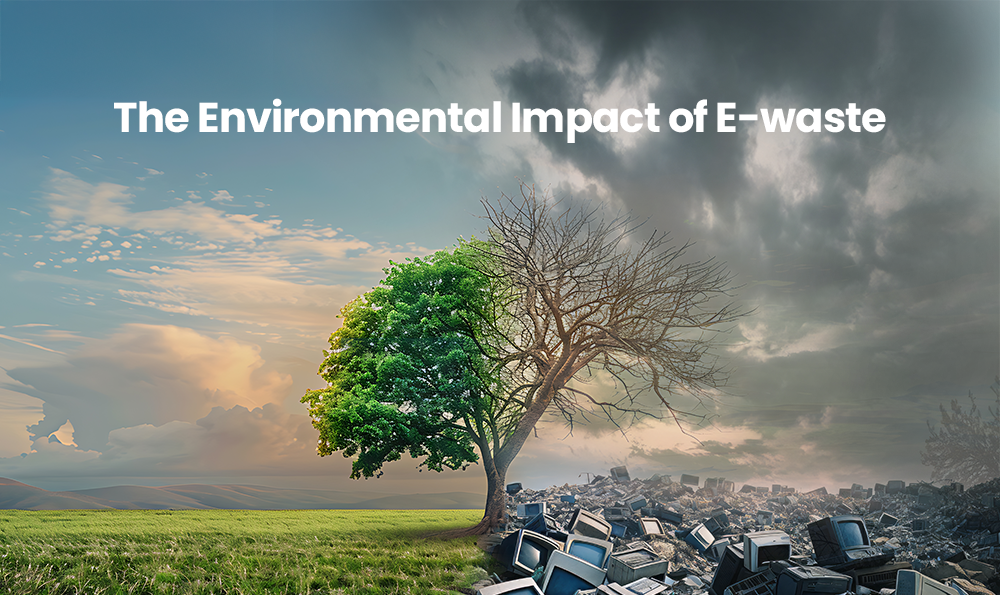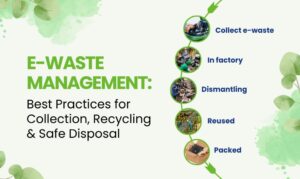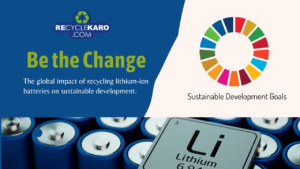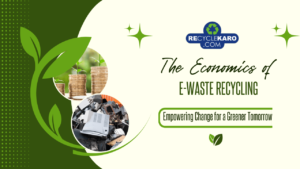The Environmental Impact of E-waste

The rapid advancement of technology has led to an unprecedented increase in electronic waste (e-waste) generation worldwide. As consumers continuously upgrade their electrical and electronic devices however, the disposal of outdated electronics has become a significant environmental concern.
E-waste encompasses discarded, electronic components from devices such as smartphones, computers, televisions, and household appliances. This blog will explore the environmental impact of e-waste, examining its effects on human health, ecosystems, and the economy, while also highlighting the importance of responsible e-waste management.
Understanding E-Waste
E-waste refers to any used electronic equipment or device that has reached the end of its useful life. This includes a wide range of products:
- Consumer Electronics: Smartphones, tablets, laptops, desktop computers, televisions, and gaming consoles.
- Home Appliances: Refrigerators, washing machines, microwaves, and air conditioners.
- Industrial Equipment: Machinery used in manufacturing processes.
- Telecommunication Devices: Phones, modems, and routers.
According to the Global E-Waste Monitor 2020 report published by the United Nations University (UNU), approximately 53.6 million metric tons of e-waste were generated globally in 2019.
This figure is projected to reach 74 million metric tons by 2030, highlighting the urgent need for effective e-waste management strategies.
Composition of E-Waste
E-waste contains a complex mixture of materials, including:
- Metals: Precious metals (gold, silver, platinum), base metals (copper, aluminum), and hazardous metals (lead, mercury).
- Plastics: Various types of plastics used in casings and components.
- Glass: Found in screens and display devices.
- Batteries: Often contain toxic substances such as cadmium and lithium.
The presence of these toxic materials also poses significant environmental risks when e-waste is improperly disposed of.
Environmental Impact of E-Waste
1. Soil Contamination
Improper disposal of e-waste can lead to soil contamination through leaching. When electronic devices waste electrical and are dumped in landfills or incinerated without proper treatment, hazardous substances can seep into the ground. Key contaminants include:
- Lead: Often found in circuit boards and soldering materials; it can cause severe neurological damage and developmental issues in children.
- Mercury: Present in batteries and fluorescent lamps; it can bioaccumulate in the food chain, affecting wildlife and human health.
- Cadmium: Commonly found in batteries; it can lead to kidney damage and bone fragility.
A study conducted by the United Nations Environment Programme (UNEP) found that e-waste disposal sites often exhibit elevated levels of heavy metals in the soil.
For instance, lead concentrations near informal e-waste recycling sites can exceed safe limits by up to 100 times, posing severe risks to local communities.
2. Water Pollution
The leaching of various toxic chemicals and substances from e-waste into groundwater can lead to significant water pollution. Contaminated water sources pose serious health risks for both humans and aquatic ecosystems. Key issues include:
- Heavy Metal Contamination: Lead, mercury, and cadmium can contaminate drinking water supplies, leading to serious health issues such as cancer and organ damage.
- Organic Pollutants: Some electronic devices contain brominated flame retardants (BFRs) that can leach into water systems. These compounds are known to disrupt endocrine systems in both humans and wildlife.
According to research published by the Basel Action Network (BAN), over 70% of toxic waste dumped in developing countries comes from e-waste. This practice exacerbates water pollution problems in regions with limited regulatory oversight.
3. Air Pollution
E-waste incineration is a common practice in many developed and developing countries due to inadequate recycling facilities. Burning e-waste releases harmful pollutants into the atmosphere:
- Dioxins and Furans: These are highly toxic compounds produced during combustion processes that can cause reproductive issues and immune system damage.
- Particulate Matter: Fine particles released during burning can lead to respiratory problems and cardiovascular diseases among local populations.
A study by the World Health Organization (WHO) indicated that exposure to air pollutants from informal e-waste recycling operations is linked to a range of health issues, including asthma, lung cancer, and other chronic respiratory diseases.
4. Impact on Human Health
The health risks of environmental pollution associated with e-waste exposure are profound and multifaceted:
- Direct Exposure: Workers involved in informal e-waste recycling often lack protective gear and are directly exposed to hazardous materials during disassembly or burning processes.
- Community Exposure: Communities near e-waste disposal sites face increased risks due to contaminated soil and water sources.
- Long-Term Health Effects: Chronic exposure to heavy metals can lead to neurological disorders, reproductive issues, and various cancers.
A report from the International Labour Organization (ILO) estimates that around 20 million people worldwide work in the informal e-waste sector, often without adequate safety measures or health protections.
5. Loss of Valuable Resources
E-waste contains a wealth of recoverable and valuable materials, that are often lost when devices are improperly disposed of. According to the Global E-Waste Monitor 2020 report:
- The total value of recoverable materials from global e-waste was estimated at around $57 billion USD in 2019.
- Precious metals like gold and silver are present in small quantities but have significant economic value when recovered properly.
By failing to recycle e-waste responsibly, society forfeits valuable resources that could be reused or repurposed for new products.
The Global Response to E-Waste Challenges
1. Regulatory Frameworks
Governments worldwide are beginning to recognize the importance of regulating e-waste electrical and electronic waste management:
- Basel Convention: An international treaty aimed at reducing hazardous waste movement between countries; it emphasizes environmentally sound management practices for e-waste.
- Extended Producer Responsibility (EPR): Many countries have implemented EPR policies requiring manufacturers to take responsibility for their products at end-of-life stages—encouraging them to design products that are easier to recycle or dispose of safely.
2. Recycling Initiatives
Several successful recycling initiatives have emerged globally:
- Certified Recycling Facilities: Organizations like R2 (Responsible Recycling) provide certification for facilities that adhere to strict environmental standards for handling e-waste.
- Public Awareness Campaigns: Many non-profits run campaigns educating consumers about responsible disposal methods for electronics while promoting recycling programs within communities.
3. Technological Innovations
Advancements in technology are helping improve e-waste recycling processes:
- Automated Dismantling Systems: New technologies allow for more efficient separation of components while minimizing exposure risks for workers.
- Hydrometallurgical Processes: Innovative methods for recovering precious metals from electronics involve using environmentally friendly solvents instead of traditional smelting techniques.
The Role of Individuals in E-Waste Management
While governments and organizations play critical roles in addressing e-waste challenges, individuals also have a part to play:
1. Responsible Disposal Practices
Consumers should prioritize responsible disposal methods for old electronics:
- Utilize certified recycling centers or participate in community collection events specifically designed for e-waste.
- Consider donating functional devices instead of discarding them—extending their lifespan while benefiting others.
2. Educating Others
Raising awareness about the environmental impact of improper e-waste disposal can help foster a culture of responsibility within communities. Sharing information through social media platforms or local events encourages others to adopt sustainable practices as well.
3. Supporting Sustainable Brands
Choosing products from companies committed to sustainable practices—including responsible sourcing materials or offering take-back programs—can drive demand for environmentally friendly solutions within industries producing electronics.
Recycle Karo is an initiative that significantly contributes to effective e-waste management by providing accessible and responsible recycling solutions. Here’s how it aligns with individual responsibilities in e-waste management:
- Certified Collection and Recycling: Recycle Karo operates certified recycling centers, ensuring that e-waste is processed in an environmentally sound manner. This supports individuals in making responsible disposal choices, as they can trust that their discarded electronics are handled properly.
- Community Engagement: The platform organizes community collection events, making it easier for individuals to dispose of their e-waste responsibly. By participating in such events, consumers can contribute directly to reducing the volume of e-waste that ends up in landfills.
- Educational Resources: Recycle Karo also focuses on educating the public about the importance of e-waste recycling and the potential hazards of improper disposal. This aligns with the individual’s role in raising awareness and fostering a culture of sustainability within their communities.
- Sustainable Practices: By promoting partnerships with brands that prioritize sustainability, Recycle Karo encourages consumers to choose products from companies committed to responsible sourcing and take-back programs. This consumer choice can drive industry-wide changes towards more sustainable practices.
Conclusion
The environmental impact of e-waste is a pressing global issue that requires immediate attention from individuals, governments, manufacturers, and organizations alike. As technology continues evolving rapidly—leading to increased consumption patterns—the need for effective e waste management rules and strategies becomes even more critical.
By understanding the dangers posed by improper disposal practices—including soil contamination, water pollution, air quality degradation, human health risks—society can work collectively toward implementing sustainable solutions aimed at minimizing these adverse effects while recovering valuable resources embedded within discarded electronics and electrical and electronic equipment.
Ultimately fostering responsible behaviors surrounding electronic waste will pave the way for a cleaner future where technology coexists harmoniously with our planet’s health—ensuring generations yet unborn inherit an environment free from pollution caused by our modern conveniences!



